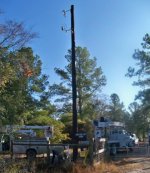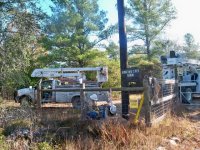terry.dinerman
Gold Member
- Joined
- Oct 11, 2009
- Messages
- 431
- Tractor
- 1990 - JD 870
The "Commissariat of Power" line crews have been spotted at TOGR! :cool2:
Just as "Joe the Inspector" promised, they swarmed the place and apparently knocked it out in one day.
None of my usual co-conspirators have had the nerve to throw the main breaker yet, so it looks like the honor will be mine....
I have some Christmas lights to decorate the meter pole for the deer...
This is a BIG step in the Master Plan....the only other development issue that requires any form of inspection out there in the unincorporated areas of my county is the septic system...
So - I am putting together my materials list for the next leg...a 300' run to the barn and a sub-panel...
One project done, another begun....I believe I will have me a cee-gar...
Just as "Joe the Inspector" promised, they swarmed the place and apparently knocked it out in one day.
None of my usual co-conspirators have had the nerve to throw the main breaker yet, so it looks like the honor will be mine....
I have some Christmas lights to decorate the meter pole for the deer...
This is a BIG step in the Master Plan....the only other development issue that requires any form of inspection out there in the unincorporated areas of my county is the septic system...
So - I am putting together my materials list for the next leg...a 300' run to the barn and a sub-panel...
One project done, another begun....I believe I will have me a cee-gar...
Attachments
Last edited:


